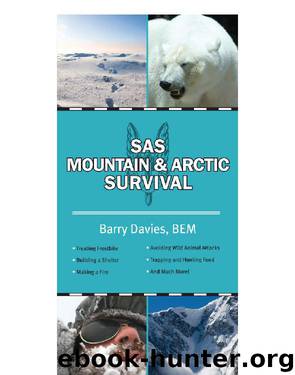The SAS Guide to Mountain & Arctic Survival by Barry Davies

Author:Barry Davies
Language: eng
Format: epub, mobi, pdf
ISBN: 978-1-62087-206-2
Publisher: Skyhorse Publishing
• Animals have more acute senses than humans, and are always on the alert for danger. Be patient; observe all potential prey; camouflage both your appearance and scent - daub mud over your face and hands. Keep a low, silent profile and use smooth, careful movement downwind while the animals are feeding. Find a good place to hide, and position yourself there well before any prospect of animal movement.
• Snares and nets work well when set around an area where an animal has been cleaned or butchered. The entrails will act as a very effective bait.
• Care must be taken when returning to a trap or a snare, as any wounded animal may be dangerous.
• A sharp whistle can stop rabbits and hares if startled into running. You may even be able to attract them to you if you make a high-pitched kissing sound with your lips on the back of your hand - this simulates a squeal.
• Birds should be watched to see if their movement will reveal a nest site containing nutritious eggs or young. These should never be overlooked as a food source.
• As a last resort, the survivor must consider eating anything that walks, flies, swims, crawls, creeps, jumps or wriggles.
• Where possible, try to use all of a carcass - do not discard anything without careful thought. Skins can be made into clothing; bones can be fashioned into arrowheads, fish hooks or needles; sinews and gut make good bow strings or sewing thongs.
Snares
Snares and traps are a far better alternative to hunting and ambushes, as they require less physical effort and time spent waiting. A well-made and correctly sited and set snare or trap will be effective 24 hours a day, without the need for constant vigilance. This method guarantees a ‘cost-effective’ meal in terms of the effort/benefit equation of survival. Start out by snaring small game; they are easier to trap, transport and prepare.
Always set several snares, but keep some distance between them; an animal caught in one snare will create enough noise to alert others to the possibility of danger. Make sure that all snares are checked on a daily basis - the caught animal may be your next meal, but there is no reason to let It suffer unnecessarily. If you are successful with any of your snares, collect the animal, kill it if necessary, and reset the snares for the next day.
Drag Snare If properly positioned the simple drag snare is a most effective way of catching a meal. Ideally the snare should be placed along a fresh run, in such a way that the animal’s head will be caught. Tie the noose to a stake which has been driven firmly into the ground; or, if it is suspended above the run, secure it to a strong branch. To set the noose, position it so that its bottom edge is about 10cm (4ins - the width of the average hand) above the floor of the run; and adjust the noose until it is about the size of two clenched fists.
Download
The SAS Guide to Mountain & Arctic Survival by Barry Davies.mobi
The SAS Guide to Mountain & Arctic Survival by Barry Davies.pdf
This site does not store any files on its server. We only index and link to content provided by other sites. Please contact the content providers to delete copyright contents if any and email us, we'll remove relevant links or contents immediately.
Whiskies Galore by Ian Buxton(41719)
Introduction to Aircraft Design (Cambridge Aerospace Series) by John P. Fielding(33016)
Small Unmanned Fixed-wing Aircraft Design by Andrew J. Keane Andras Sobester James P. Scanlan & András Sóbester & James P. Scanlan(32684)
Aircraft Design of WWII: A Sketchbook by Lockheed Aircraft Corporation(32162)
Craft Beer for the Homebrewer by Michael Agnew(18081)
Turbulence by E. J. Noyes(7894)
The Complete Stick Figure Physics Tutorials by Allen Sarah(7264)
The Institute by Stephen King(6859)
Kaplan MCAT General Chemistry Review by Kaplan(6822)
The Thirst by Nesbo Jo(6758)
Bad Blood by John Carreyrou(6476)
Modelling of Convective Heat and Mass Transfer in Rotating Flows by Igor V. Shevchuk(6353)
Learning SQL by Alan Beaulieu(6158)
Weapons of Math Destruction by Cathy O'Neil(6084)
Man-made Catastrophes and Risk Information Concealment by Dmitry Chernov & Didier Sornette(5877)
Permanent Record by Edward Snowden(5681)
Digital Minimalism by Cal Newport;(5586)
Life 3.0: Being Human in the Age of Artificial Intelligence by Tegmark Max(5404)
iGen by Jean M. Twenge(5324)
